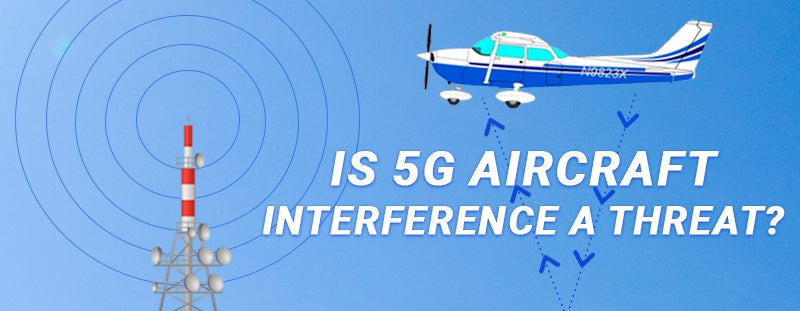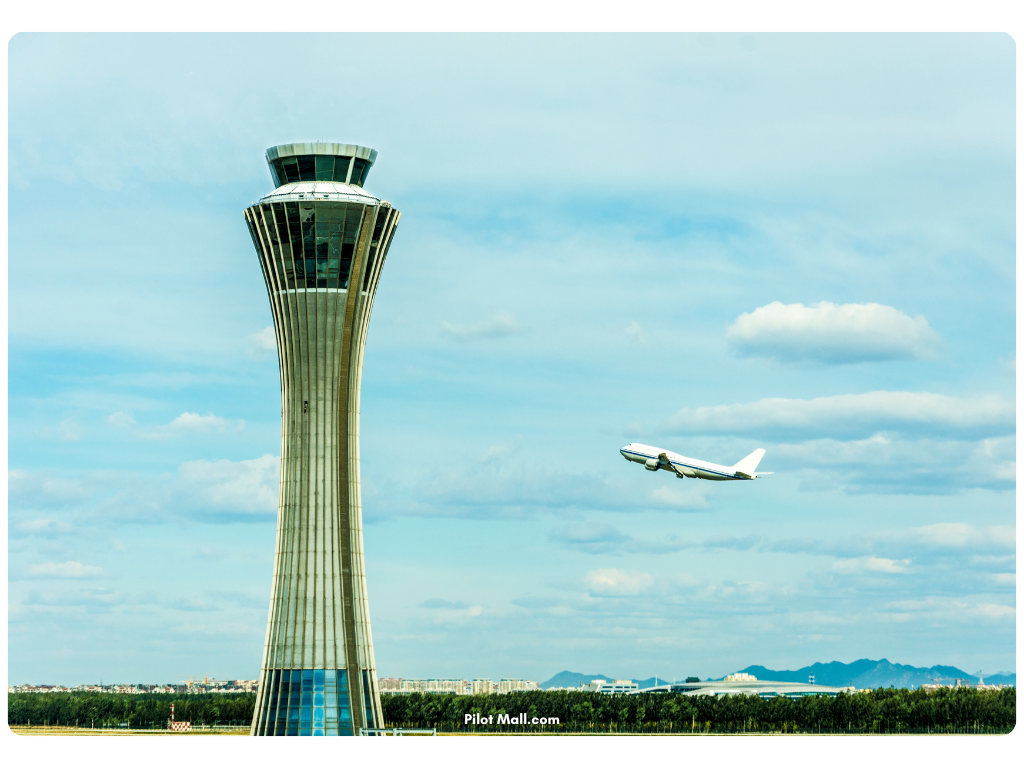Is 5G Aircraft Interference a Threat? What You Need to Know.
We all know the drill. Once the doors close on a commercial airline flight, all passengers are asked to place their portable electronic devices into airplane mode. The flight attendants then come through and extend a personal invitation to any stragglers who are still trying to sneak in that last second call or message.

Featured Pilot Gear
Browse our selection of high-quality pilot supplies! Your purchase directly supports our small business and helps us continue sharing valuable aviation content.
Once the doors close on a commercial flight, passengers are asked to put their devices in airplane mode. Flight attendants give personal reminders to stragglers trying to sneak in last minute calls or messages.
But why is this such a big deal? We'll answer that in this article.
Let's begin!
 Airplane Mode Please
Airplane Mode Please
The reason behind the no cellular functions mandate on commercial flights is that the FAA is concerned 3G and 4G cell carrier signals could interfere with aircraft navigational and landing systems.
Now the rollout of new 5G cellular networks from major carriers like AT&T, T-Mobile, and Verizon has pilots, airlines, and the FAA facing questions about what impact 5G interference can have on aircraft.
If you’re not sure what the deal is with the 5G controversy and whether you as a pilot should be concerned, keep reading.
We will explain what 5G is, how it works, what potential problems it could cause for pilots, and how the Federal Aviation Administration (FAA) is responding to the 5G rollout.
What is 5G?
For starters, let’s talk about what the term “5G” actually means. Those who aren’t tech-savvy or overly interested in tech news will be forgiven for having only a vague understanding of what 5G is and why it matters to pilots.
In simple terms, 5G is the name given to the most recent iteration of cellular network technology. The “G” in 5G stands for “generation,” meaning that 5G is simply the 5th generation of wireless cellular networks.
The purpose of the 5G upgrade is to provide enhanced services at speeds that are 10 times as fast as those of 4G networks.
5G Explained
If you recall the box phones from the 1990s, you will remember using 1G technology.
-
1G: Original 1G signals were analog and supported voice only calls, often with poor quality.
-
2G: Starting with 2G, mobile broadband signals became digital and introduced text and media messaging data services in addition to voice.
-
3G: The 3G rollout supported basic mobile internet access.
-
4G: 4G allowed video streaming, gaming, and video conferencing.
-
5G: The new 5G deployment started in 2019 and is designed to support even faster data rates with decreased latency (or delay).
It will also offer larger scale uses for industry and government purposes. Users will be able to connect their 5G-enabled devices to any other device with a 5G-compatible chip for an interconnected “internet of things.”
Each generation of cellular network has operated on different frequency bandwidths and has provided improved speed and capabilities compared to previous generations.
Current 5G networks include two different frequency ranges. The first, a high-frequency millimeter wave (mmWave) operates between 28-39 Gz and is of no consequence for pilots.
The second 5G frequency range is known as the C-band. It operates between 3.7-3.98 GHz and is the focus of current conversations about 5G interference with aircraft.
 Does 5G Interfere with Planes?
Does 5G Interfere with Planes?
As the FAA reviews the implications of widespread 5G implementation, one major area of concern has been 5G aircraft interference.
Since the C-band radio frequencies used for some 5G spectrum services are close to those used by aircraft radio altimeters, there is a potential for hazardous interference.
It depends on the equipment, frequencies, proximities, and other variables, but the short answer is: yes, in certain cases, 5G may interfere with airplanes.
Why Does 5G Interfere with Airplanes?
When aircraft are within 2,500 feet of ground level, an instrument called an aircraft radio altimeter is used to determine the aircraft’s height above ground level (AGL).
The radio altimeter transmits a radio signal from the aircraft, then measures the change of phase between the original signal and the reflected signal.
The phase change denotes aircraft height relative to the ground. Radio altimeters are most crucial for flights landing in low visibility conditions.
The signals sent out by radio altimeters are supposed to be within the 4.2-4.4 GHz band range designated by the Federal Communications Commission (FCC).
In theory, that means that the new 5G mobile telecommunications signals sent out in the C-band spectrum at frequencies between 3.7 and 3.98 GHz should be no problem.
The gap of 0.22 GHz creates a “guard band” which should be sufficient to prevent overlap between 5G signals and radio altimeter signals. Unfortunately, that may not always be the case, depending on the sensitivity level of the individual altimeters used onboard aircraft.
How Can 5G Interfere with Planes?
Some pilots have already reported radio altimeter interference when flying near 5G signal transmitters and receivers. The problems for these aircraft systems are caused by signal overlap.
Signal overlap occurs when an aircraft’s radio altimeter is not sensitive enough to receive only signals within its dedicated 4.2-4.4 GHz band.
Since the 5G band is only 0.22 GHz away, a low-sensitivity radio altimeter can pick up 5G cellular signals and mistake them for the reflected radio wave.
If a 5G signal overlaps and interferes with the signal emitted by or reflected to an aircraft’s radio altimeter, the measured phase change will be inaccurate.
The altimeter will either tell the pilot that the plane is closer to or further from the ground than it truly is. The instrument can also fail completely due to interference.
In practice, most reports of potential 5G signal interference have involved pilots receiving ground proximity warnings when they are not close to the ground.
In theory, 5G interference could also affect navigation instruments, Traffic Collision Avoidance System (TCAS), and terrain awareness systems since they too receive data from the radio altimeter.
The good news is that a high-quality, sensitive altimeter should not pick up 5G signals at all, and if it does, it can register the signals as noise and filter them out.
 What is the FAA’s Position on the 5G Rollout?
What is the FAA’s Position on the 5G Rollout?
As the agency responsible for aviation policies and safety in the United States, it is important for the Federal Aviation Administration (FAA) to play a role in the 5G rollout process.
In December of 2021, the FAA released an official statement saying the agency “believes the expansion of 5G and aviation will safely co-exist.”
Two airworthiness directives, one for fixed wing aircraft and one for helicopters, were also simultaneously released to further explain the FAA’s initial concerns about interference potential and to advise pilots of upcoming NOTAMs that would “prohibit certain operations requiring radio altimeter data” at designated 5G-impacted locations.
The FAA has created a 5G and Aviation Safety information page to address the potential for 5G interfering with airplanes and share what is being done to minimize risk.
The FAA’s goal is “to ensure that radio signals from newly active wireless telecommunications systems can coexist safely with flight operations in the United States, with input from the aviation sector and telecommunications industry.”
The FAA is testing current aircraft altimeters and clearing those that are sensitive enough not to be affected by 5G signals. Aircraft with altimeters that are deemed unaffected by 5G are issued an AMOC (approval of an alternative method of compliance).
The agency has also worked with cell service providers to set up temporary 5G deployment exclusion zones around fifty of the busiest US airports while altimeter testing continues.
 Which Altimeters Has the FAA Cleared for Use Near 5G?
Which Altimeters Has the FAA Cleared for Use Near 5G?
Upgrading altimeters or adjusting existing altimeters is pricy, leaving both airlines and pilots hoping their current equipment makes the cut and is deemed 5G safe.
The good news is that following altimeter testing, most aircraft are being approved for low-visibility landings in 5G deployment zone airports.
The continually updated map on the FAA’s 5G information page shows which airports are currently impacted by 5G deployment sites.
You can also view which aircraft have gone through the AMOC process and received approval to carry out altimeter-supported operations within that airspace. If your aircraft has received a relevant AMOC, the restrictions of the 5G NOTAM to do not apply to you.
Takeaways
Although there have been implementation concerns and challenges in the United States regarding 5G, the FAA is working with cellular service providers to mitigate any potential hazards that the network rollout could pose to aircraft.
Some radio altimeters are less sensitive than others and could have difficulty filtering out or disregarding 5G cell signals they pick up, therefore the FAA is testing all altimeters.
As a pilot, you should review the relevant NOTAMs and AMOCs to confirm what types of operations your aircraft is currently cleared to conduct at any 5G impacted airports.
If your aircraft’s altimeter hasn’t been cleared yet, you won’t be able to perform low-visibility landings in these airports.
Brush Up on NOTAMS
Preparing for a low visibility landing or want to brush up on reading a NOTAM? Here are some posts for you:
- 9 Types of NOTAMS Used in Aviation (Guide)
- Airport Runway Lights: Spacing and Colors (All the Details)
- How to Read Airport Signs (Everything You Need to Know)
Did you find this article helpful?
Do you think we missed anything important? Let us know in the comments below!






























